
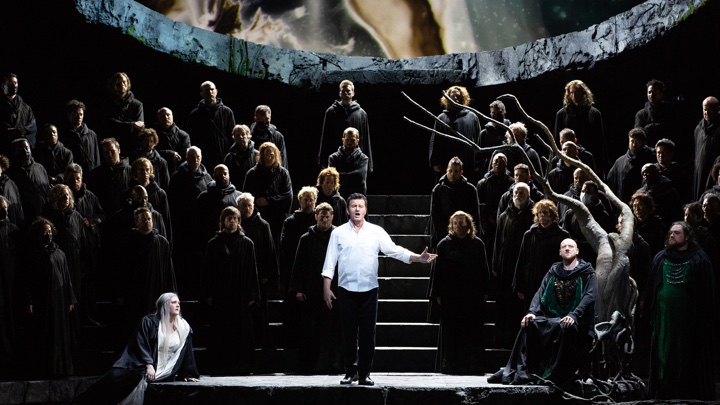
In Girard’s imagination, Lohengrin is an extra-terrestrial—a celestial being come down from outer space in a swan-shaped spacecraft that cuts across the constellations, nebulas, and solar systems that constitute the backdrop of his production. He has Jedi-like abilities, staving off Friedrich’s attacks using the power of “The Force.” When Elsa asks his name, he makes like E.T. and “phones home,” hopping back on his spaceship and zooming off to planets yonder.
The sets (by Tom Yip) look like discarded mock-ups for the Galaxy’s EdgeTM attraction at Disney World and the projections (by Peter Flaherty)—although infinitely more beautiful than the two-bit graphics which adorned LePage’s Ring—gave the impression that the Starship Enterprise could fly across the mise-en-scène at any time.
But where Girard’s Lohengrin most resembled a Star Wars film was in its simple, diametric opposition between good and evil. In Girard’s world there are heroes and there are villains and the heroes are righteously good and the villains are melodramatically bad and there is absolutely no room for dramatic nuance.
And just as George Lucas felt the need to give different colored lightsabers to differentiate between heroes and villains, so Girard believes that his audience can’t tell the difference between his “good” and “bad” characters without dressing them in different colors.
Ortrud and Friedrich stalk the stage in red capes like the Count and Countess Dracula. Lohengrin is in a crisp white dress shirt while Elsa wears an eggshell peignoir and (truly hideous) blonde hair extensions—looking like a couple of teenagers who utterly failed to coordinate their prom outfits. Unfortunately, the morally neutral King Heinrich wears forest green, so there are times when the stage resembles a rather sad Christmas tree floating in space.
Girard’s great “innovation” was costuming the chorus in black cloaks with a lining capable of changing color with the drama: when the chorus are “evil,” the lining of their coats is red; when they are “neutral,” the lining is green; and when they are “good,” it is white.
I thought this was a wonderful gimmick… for about 15 minutes—and then it began to grate on me. Unfortunately, Girard could think of nothing better for the chorus to do than to flap their coats open and closed for hours on end like compulsive subway flashers. Lohengrin is Wagner’s greatest choral work, and yet Girard treated his chorus as little more than set dressing: They seemed to have no identity, no character, no life, no energy, beyond their ability to bear the symbolism of Girard’s technicolor turncoats.
The opera’s monumental choral set pieces—usually such highlights of the opera—were staged with such little imagination: just a whole bunch of people slowly processing in white cloaks (Girard clearly didn’t think through the optics of this given Wagner’s anti semitism). Everything seemed so static, so hemmed in, as if Girard didn’t quite know how to fit that many people onto his set without simply having them stand around.
To me, the staging felt lazy: creatively lazy in its flagrant borrowing from science fiction, intellectually lazy in its simplification of the opera’s characters, and logistically lazy in deployment of theatrical space. I felt a little patronized, to be honest: beaten over head with imagery that dumbed down the plot to a series of basic antagonisms and bored to tears by a staging that felt phoned in, I left feeling that Girard’s staging had absolutely nothing profound or interesting to say about Wagner’s work.
This was an immense shame, because I greatly enjoyed the musical interpretation as a whole, even if I felt that many of the singers seemed a little lost, mismatched, or out-of-place in Girard’s production. I got the sense that many of the performances may have been elevated in a production that provided its singers with greater dramatic scope—one which didn’t constrict them to such bland interpretations of their characters and to such limited use of the theatrical space.
This was certainly the case for Tamara Wilson’s Elsa. The soprano sang splendidly. Hers was not an overly large voice, but it had a full, lustrous body and a bright top that projected well in the house. A reserved, slightly hushed start (with a delicious, pianissimo “Einsam in trüben Tagen”) paced the soprano well for more explosive, searing encounter with Lohengrin in the third act.
I particularly appreciated the mellow lyricism with which Wilson approached Wagner’s score: her lines unfolded with an electrifying sense of melodic continuity, seemingly defying the composer’s worst tendencies towards recitative. And yet her performance was never gushing or over-the-top, always marked by a welcome sense of artistic restraint, allowing the nuances of her voice to inflect the vocal line.
However, Wilson’s Elsa seemed a little vacant onstage. Moments in her character arc that should have been intimate or heartfelt came across as a stilted and oddly devoid of emotion. She hardly seemed to react when Lohengrin burst in to rescue her and seemed absolutely nonplussed when he said he would marry her.
Piotr Beczala’s Lohengrin also felt rather stiff—rare for a performer whose stage presence is usually so warm and passionate. His interpretation of the title role came off a tad cold and unfeeling: rather than zealous, heroic, and chivalrous, his Lohengrin seemed calculated and sociopathic.
Together, they could not have had less chemistry. This was not a musical problem but a dramatic one. If you closed your eyes during their duet in Act III, you would hear fiery, impassioned vocal performances from both singers; but open your eyes and you’d be confronted with the frigid sight of two of the world’s leading opera singers looking more awkward than an undertaker at a baptism.
I cannot stress more that this stiffness was not the fault of the singers themselves. It’s hard to blame this on the performers when the director’s only direction seems to have been to “wear white and be good.” There must be more to Elsa and Lohengrin’s relationship than standing stoically singing in spotlights, but Girard doesn’t seem to have figured out what that is yet. In the meantime, the audience is left to wonder what on earth could have attracted these two entirely soulless protagonists to each other.
General manner aside, Beczala delivered a powerhouse performance in the opera’s title role. I have mostly heard the tenor in Italianate roles of the bel canto and verismo traditions (most recently his Count Loris in Fedora). His voice was like an entirely in this Germanic repertoire: heartier, throatier, more orotund—less tart, shiny, and lusty but with no less weight or resonance. His “In fernem Land” was the quintessential Wagnerian narration, balancing raw vocal power with vividly expressive musical storytelling.
This slightly more stentorian sound very much suited the austerity of Wagner’s writing for Lohengrin, foregrounding the hardy core of Beczala’s voice. The middle register was particularly magisterial, without ever feeling pushed, forced, or overly muscular. His “Nun sei bedankt, mein lieber Schwan,” for example, had a tender beauty and a commanding immediacy, communicating a certain force without sacrificing elegance or nuance.
If Beczala’s Lohengrin and Wilson’s Elsa seemed a little understated onstage, Christine Goerke’s scenery-eating Ortrud had the opposite problem. Georke played Ortrud like the archetypical pantomime villain—hunched over, lurking in the shadows, rubbing her hands together, mumbling to herself, clenching her fists, snarling, snorting, gesticulating maliciously.
It was a Big Performance—think Faye Dunaway‘s Joan Crawford meets Pat Carroll as Ursula. And it was eminently enjoyable to watch: it was fun, energetic, hammy, even a little ostentatious. Yet, like all of Girard’s characters, it was all too two-dimensional. There was no depth to this Ortrud beyond her evilness: no complexity to her drives, no richness to her emotional life.
What’s more, the farcical, sneering villainy of Goerke’s performance seemed at odds with the strange aloofness of Girard’s “heroic” characters. The entire production felt like a peculiar grab-bag of disjointed, ill-matched performances that failed to gel under the directorial vision.
Goerke was in particularly excellent voice on opening night. This slightly lower role suits her marvelously. She had the raw strength in the lower regions of her voice to carry Ortrud’s deeper tessitura, while maintaining the bright, piercing quality of a dramatic soprano in the middle and upper registers. Goerke’s tough, sinewy chest voice served her well here, allowing her to pack a punch on the lower notes without sacrificing expressive agility.
Hers was a colorful performance, rich in expressive effects, varied in its flavor, exciting in its range of vocal hues. I particularly enjoyed the crispness of Goerke’s articulation, which often seemed to extend from the consonants into the timbre of the notes themselves: her melodic lines seemed to be tinged with the color of the words it carried. This didn’t necessarily make for a uniformly “beautiful” interpretation (there could be the odd harsh or reedy note) but it did make for a thrilling, utterly musical, wholly Wagnerian performance.
Goerke’s Ortrud found an exquisite match in Evgeny Nikitin’s Friedrich. For me, Nikitin was a vocal standout from the opera’s very opening: in the first act, his spry, sonorous baritone cut over Wagner’s orchestra with a delightful sparkle. His high register was especially impressive—bright, with plenty of cut, but also warm and rounded.
Nikitin exhibited some signs of strain over the course of the opera: in the second act, his voice became increasingly lost in the orchestral texture, losing some of the sheen that it had exhibited so strikingly in the first act. But even as he lost volume, he never sacrificed the energetic, heady quality of his sound, finding fresh beauty in a character so often painted as a curmudgeonly rogue.
Günter Groissböck’s King Heinrich felt a little undercooked to me. So much of his role is made up of big, grand declamations, and yet I often struggled to hear him. The lower registers were a tad too gruff for me while the high notes came across as pinched. Brian Mulligan fared better as Heinrich’s herald, crying out into Girard’s vast galaxy with stentorian passion.
If there is one overpowering reason to see this production, it is for Yannick Nézet-Séguin’s conducting.
There was something magical about listening to him leading the Metropolitan Opera Orchestra through Wagner’s overture. I must have heard the prelude to Lohengrin upwards of a hundred times on recording. And yet it felt like I was listening to an entirely new piece of music.
There were notes in Wagner’s score that I’d never heard before, ways that the chords converge and diverge that had previously defied my ear, instrumental lines that sounded like they’d been composed specifically for that performance. Even the simple A major chords which open the prelude seemed entirely foreign to me, as if Nézet-Séguin had found an entirely new way of voicing them.
For me, it was a revelatory approach to Wagner’s opera. To me, Nézet-Séguin often seemed to emphasize the uniqueness of instrumental timbre over orchestral cohesion. The score appeared to unfold not in blocks of sound, but in various, jostling sonic tendrils which just happened to intersect to form chords and melodies.
The oboes, for example, had a particularly acrid, nasal character, which cut through the wiry morass of string lines in interesting and compelling ways. And the brass—a crucial component of this opera—had a plump, corpulent sound (not harsh or brilliant at all) that allowed us to hear the wider orchestral harmonies underpinning their fanfares.
If I felt that Nézet-Séguin’s tempi were a little indulgent in the second and third acts, it was probably only because I was so eager to be done with Girard’s production. Indeed, the more I listened to this outstanding performance, the more I thought that it was a mighty shame that this conductor, this orchestra, and this cast were not given a production worthy of their artistic efforts.
Photos: Marty Sohl / Met Opera














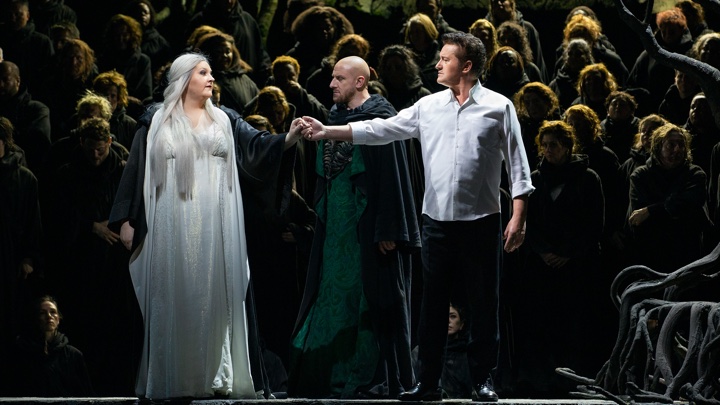
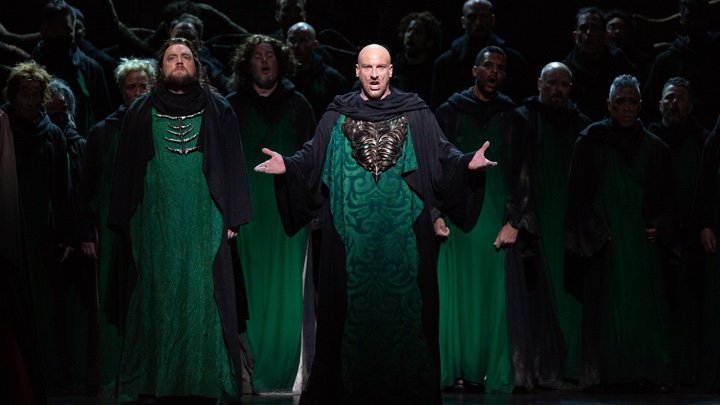
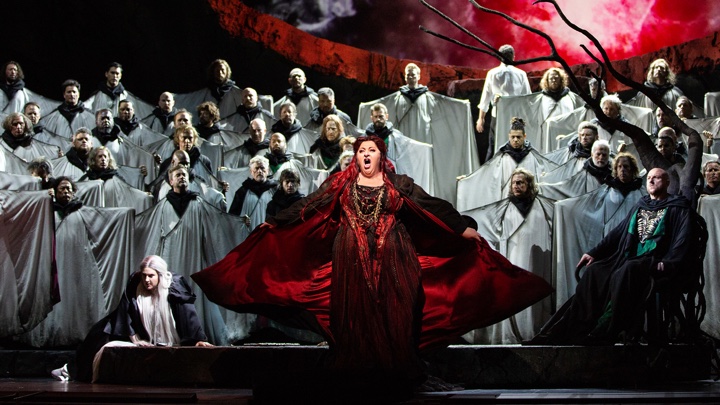
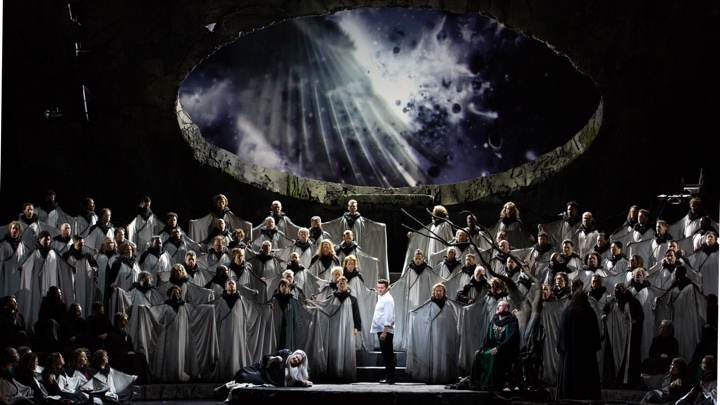











Comments